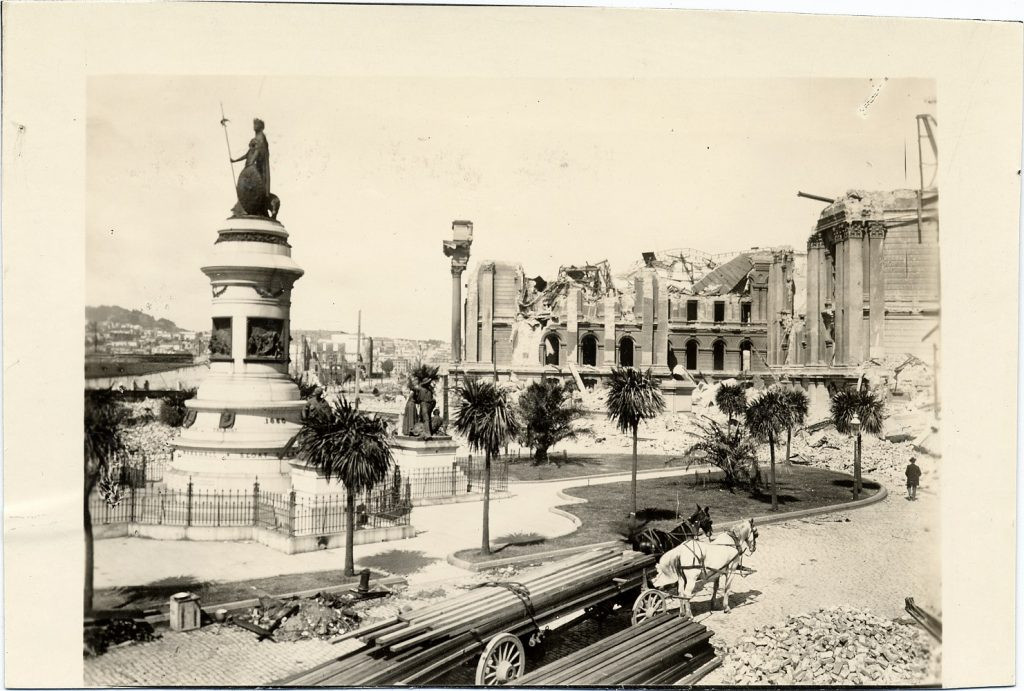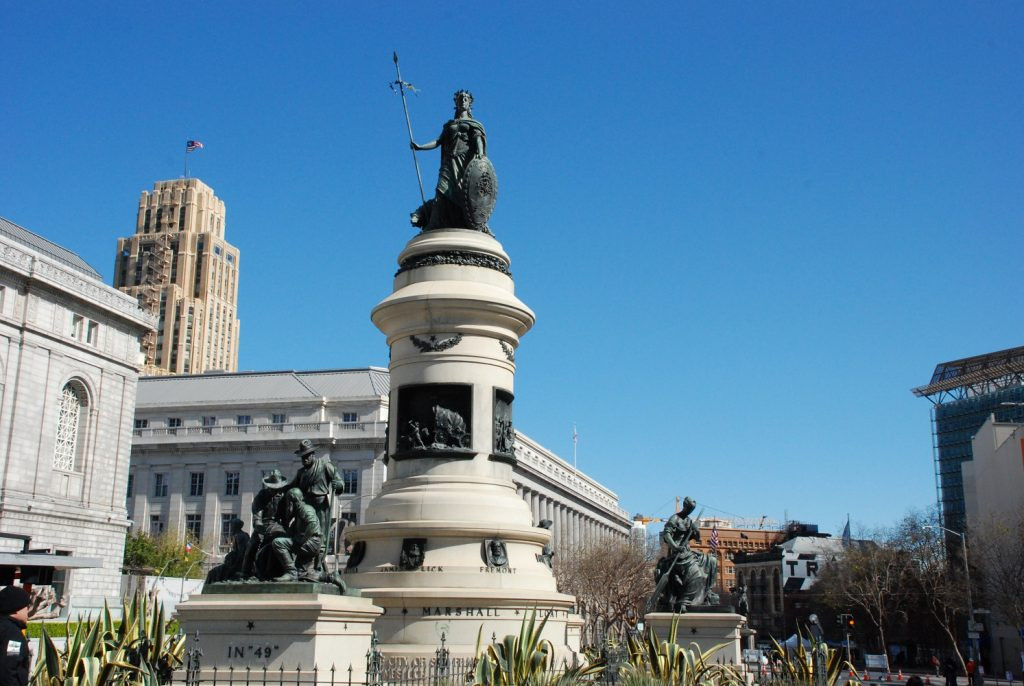The James Lick Pioneer Monument in San Francisco, sculpted by Frank Happersberger, stands as a complex representation of California’s history, reflecting a narrative of white American dominance. Commissioned by the eccentric millionaire James Lick, who amassed his fortune in real estate during the California Gold Rush, the monument was intended as a “statuary emblematic of the significant epochs in California history.” This ambitious project, funded by a substantial bequest from Lick, aimed to visually narrate California’s past, particularly emphasizing the Anglo-American perspective.
Erected initially in front of the old City Hall in 1897, the Pioneer Monument remarkably withstood the devastating 1906 San Francisco earthquake and fire. Its survival cemented its status as a symbol of the city’s resilience and determination to rebuild.
 Pioneer Monument and ruins of City Hall, 1906.
Pioneer Monument and ruins of City Hall, 1906.
The monument’s design centers around a prominent granite column, adorned with bronze sculptures and reliefs that collectively construct a specific historical narrative. This narrative glorifies the contributions of white Americans in shaping California. It starts by romanticizing the Spanish colonial era, portraying Spanish missionaries in a benevolent light and celebrating the elite Spanish landowners. At the base of the column, four scenes combine allegorical female figures, representing the perceived benefits of Euro-American civilization, with key male historical figures.
One of these scenes, titled Early Days, depicts a Spanish missionary interacting with a Native American man, symbolizing the Spanish mission period (1769-1821). A Spanish Californian vaquero is also present, representing the Mexican era (1821-1848). Another scene features Anglo-American miners from the 1849 gold rush, notably omitting the presence and contributions of Chinese, Mexican, and Indigenous miners during this transformative period. Relief plaques further embellish the pedestal, depicting scenes like vaqueros lassoing a bull, a white trapper trading with Native Americans, and Anglo-American families traversing the Sierra Nevada. The dates 1848 and 1850, marking the gold discovery and California statehood respectively, are also prominently displayed.
 Frank Happersberger, Lick Pioneer Monument, 1894.
Frank Happersberger, Lick Pioneer Monument, 1894.
Encircling the granite pillar are portrait medallions of white men whom Happersberger credited as founders of California. The narrative begins with Sir Francis Drake’s claim of the region for England in 1579 and Father Junipero Serra’s establishment of the Spanish mission system in 1769. Instead of highlighting wealthy Latino landowners from the Mexican era, the monument honors figures like Swiss immigrant John Sutter, known for utilizing Native labor, alongside American explorer John C. Frémont and the monument’s benefactor, James Lick himself.
Below these portraits, additional names associated with California history are inscribed. These include Spanish and Mexican leaders like Juan Rodriguez Cabrillo, Gaspar de Portolá, José Castro, and Mariano Guadalupe Vallejo. Less prominent, but still recognized, are white Americans such as Thomas O. Larkin, Commodores John D. Sloat and Robert F. Stockton, and James Marshall.
Initially, the monument’s design and message were widely celebrated. Press coverage lauded Happersberger’s depiction of “white progress,” reflecting the prevailing societal views of the late 19th and early 20th centuries. Any deviation from this narrative of progress was met with public disapproval.
However, perspectives began to shift in the latter half of the 20th century. The Civil Rights Movement and growing awareness of historical injustices prompted Native American activists and historians to challenge the monument’s glorification of conquest and white supremacy. By the 1990s, as San Francisco considered relocating the monument, its controversial nature came under increased scrutiny.
 “Early Days.” Detail of Frank Happersberger, Lick Pioneer Monument, 1894.
“Early Days.” Detail of Frank Happersberger, Lick Pioneer Monument, 1894.
Preservationists advocated for maintaining the monument’s original location, while Native activists argued against its relocation to a more prominent site, viewing it as a celebration of genocide. Ultimately, city leaders responded by moving the monument in 1993 and adding a plaque in 1996 to provide a more balanced perspective, acknowledging the negative impacts of colonization on Native populations. Even the wording of this plaque sparked controversy, highlighting the sensitivity surrounding the monument’s historical interpretations. The plaque ultimately stated that approximately half of the Native population perished due to European arrival, citing disease, violence, and mistreatment.
Despite the added plaque and relocation, the monument’s accessibility remained limited due to traffic patterns and landscaping. In 2017, amidst a national debate about Confederate monuments, renewed attention focused on the Pioneer Monument. The San Francisco Arts Commission voted to remove the Early Days grouping specifically. Following legal challenges and public debate, the Early Days sculpture was removed in 2018. The rest of the monument remains standing, a complex and contested landmark in San Francisco, prompting ongoing dialogues about how history is represented in public spaces.
Related Monuments:
- Douglas Tilden, Admission Day Monument, 1897
- Charles Grafly, Pioneer Mother, 1915
- Solon Borglum, American Pioneer, 1915-1980
- James Earle Fraser, End of the Trail, 1915
Explore Further:
- San Francisco Pioneer Monuments Walking Tour powered by Clio
- Northern California Pioneer Monuments Driving Tour powered by Clio
Notes:
[1] Helen Wright, James Lick’s Monument: The Saga of Captain Richard Floyd and the Building of the Lick Observatory (Cambridge [Cambridgeshire] ; New York: Cambridge University Press, 1987).
[2] Frank Happersberger, The Pioneers Monument, November 29, 1894, November 29, 1894, http://siris-artinventories.si.edu/.
[3] Diana Scott, “Public Art: Whose Version of History?” Albion Monitor May 5, 1996.
